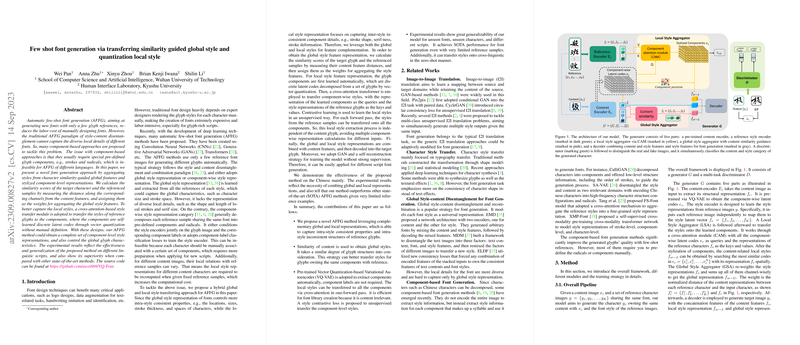Few-Shot Font Generation by Transferring Similarity-Guided Global and Local Styles
The presented paper introduces a novel method to tackle the problem of automatic few-shot font generation (AFFG), which aims at synthesizing new fonts with minimal glyph references. The proposed approach diverges from the traditional style-content disentanglement by focusing on the aggregation of styles via similarity-guided global features and quantized local representations. This framework presents an innovative solution to overcome limitations encountered in previous AFFG models, making it adaptable across different linguistic scripts and reducing reliance on predefined glyph components.
Key Methodological Components
The authors propose a dual-style aggregation approach, combining global and local style representations. For the global style, the method uses similarity scores between the target character and reference samples, derived from content feature distances, to weight and aggregate global style features. This ensures that global style features, affecting overall font characteristics such as character size and stroke thickness, are transferred effectively.
Local style capture is achieved through a cross-attention-based module, where reference glyphs' styles are transferred to character components. Notably, these components are learned as discrete latent codes using vector quantization, eliminating the need for manually defined components like strokes or radicals. This self-supervised learning approach via contrastive learning significantly enhances the adaptability and efficiency of font generation.
Experimental Insights
The experimental evaluation conducted primarily on Chinese fonts demonstrates the advantages of integrating global and local style representations. The model shows superior performance compared to several state-of-the-art methods, such as FUNIT, AGIS-NET, and MX-Font, particularly in generating visually appealing fonts with limited samples.
Quantitative results are corroborated by qualitative analysis, highlighting the model’s ability to maintain structure and stylize details successfully. The results indicate a substantial improvement in metrics such as SSIM, RMSE, and FID. Furthermore, the approach demonstrates robust generalization capabilities across different and unseen fonts, as well as the ability to handle cross-linguistic characters, extending its applicability to scripts other than Chinese.
Theoretical and Practical Implications
The paper provides a significant theoretical contribution to the AFFG landscape by addressing the inherent challenges of global-only style representation methods and component-based models. The utilization of vector quantization for component learning is particularly noteworthy, offering a flexible solution adaptable to various scripts without extensive pre-definition efforts.
On the practical side, the flexible nature of this model could lead to more efficient workflows in font design, especially in contexts demanding rapid typographic diversification or the creation of unique graphic identities, such as branding or text-based AI applications. By reducing the number of necessary reference characters, this approach helps ease the workload on professional font designers and opens the avenue for non-experts to partake in creative font creation.
Future Directions
While the proposed method achieves considerable success, the paper acknowledges certain limitations, such as performance dependency on the number of references and challenges with highly decorative fonts. Future research endeavors could focus on mitigating these limitations by exploring unsupervised refinement techniques or expanding the model's capacity to synthesize complex font decorations.
Further potential development could explore integration with design tools or web-based applications, facilitating more intuitive font creation processes. Enhancing the interpretability of the style representations and fostering inclusivity for underrepresented scripts or characters would also strengthen the model's universal applicability and impact within the typographic and AI sectors.
Overall, the paper lays a robust foundation for developing advanced AFFG practices, bridging the gap between automatized and human-driven font design processes.
